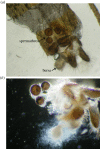Satyrization without evidence of successful insemination from interspecific mating between invasive mosquitoes
- PMID: 26382076
- PMCID: PMC4614430
- DOI: 10.1098/rsbl.2015.0527
Satyrization without evidence of successful insemination from interspecific mating between invasive mosquitoes
Abstract
Previous research has documented low frequencies of interspecific mating in nature between the invasive vectors Aedes aegypti and Aedes albopictus. It is also known that heterospecific male accessory gland substances transferred during mating sterilize A. aegypti but not A. albopictus females, leading to satyrization, a form of reproductive interference. This paper demonstrates that satyrization of A. aegypti by A. albopictus may occur without evidence of successful insemination. Our results show that A. aegypti females, previously exposed to A. albopictus males, are rendered refractory to subsequent conspecific mating even though their spermathecae contain no heterospecific sperm. Additional experiments demonstrating transfer of labelled semen from A. albopictus males to A. aegypti females and low production of viable eggs of females housed with conspecific males, following exposure to A. albopictus males, confirm higher incidences of satyrization than expected, based on heterospecific insemination rates. We conclude that frequencies of satyrization based on detection of interspecific sperm in spermathecae may underestimate the impact of this form of reproductive interference.
Keywords: Aedes aegypti; Aedes albopictus; empty spermathecae; reproductive interference; satyrization.
© 2015 The Author(s).
Figures


Similar articles
-
Satyrization and satyrization-resistance in competitive displacements of invasive mosquito species.Insect Sci. 2016 Apr;23(2):162-74. doi: 10.1111/1744-7917.12291. Epub 2016 Jan 18. Insect Sci. 2016. PMID: 26542083 Review.
-
Competitive reduction by satyrization? Evidence for interspecific mating in nature and asymmetric reproductive competition between invasive mosquito vectors.Am J Trop Med Hyg. 2011 Aug;85(2):265-70. doi: 10.4269/ajtmh.2011.10-0677. Am J Trop Med Hyg. 2011. PMID: 21813845 Free PMC article.
-
Asymmetrical reproductive interference between Aedes aegypti and Aedes albopictus : Implications for coexistence.J Vector Borne Dis. 2024 Oct-Dec 01;61(4):547-554. doi: 10.4103/JVBD.jvbd_40_24. Epub 2024 Nov 26. J Vector Borne Dis. 2024. PMID: 38965875
-
Demonstration of resistance to satyrization behavior in Aedes aegypti from La Réunion island.Parasite. 2020;27:22. doi: 10.1051/parasite/2020020. Epub 2020 Apr 7. Parasite. 2020. PMID: 32254018 Free PMC article.
-
The Importance of Interspecific Interactions on the Present Range of the Invasive Mosquito Aedes albopictus (Diptera: Culicidae) and Persistence of Resident Container Species in the United States.J Med Entomol. 2016 Sep;53(5):992-1001. doi: 10.1093/jme/tjw095. Epub 2016 Jun 28. J Med Entomol. 2016. PMID: 27354436 Review.
Cited by
-
Laboratory colonization of the European invasive mosquito Aedes (Finlaya) koreicus.Parasit Vectors. 2017 Feb 10;10(1):74. doi: 10.1186/s13071-017-2010-2. Parasit Vectors. 2017. PMID: 28183328 Free PMC article.
-
Reproductive interference and Satyrisation: mechanisms, outcomes and potential use for insect control.J Pest Sci (2004). 2022;95(3):1023-1036. doi: 10.1007/s10340-022-01476-6. Epub 2022 Feb 8. J Pest Sci (2004). 2022. PMID: 35535033 Free PMC article. Review.
-
Where Vectors Collide: The Importance of Mechanisms Shaping the Realized Niche for Modeling Ranges of Invasive Aedes Mosquitoes.Biol Invasions. 2018 Aug;20(8):1913-1929. doi: 10.1007/s10530-018-1674-7. Epub 2018 Jan 25. Biol Invasions. 2018. PMID: 30220875 Free PMC article.
-
Characterizing Physical Interactions between Male and Female Mosquitoes (Aedes aegypti) in Relation to Female Receptivity and Insemination Outcomes Using a Hydrophobic Fluorescent Dye.Integr Comp Biol. 2023 Aug 23;63(2):382-392. doi: 10.1093/icb/icad041. Integr Comp Biol. 2023. PMID: 37245059 Free PMC article.
-
Aedes aegypti Males as Vehicles for Insecticide Delivery.Insects. 2019 Aug 1;10(8):230. doi: 10.3390/insects10080230. Insects. 2019. PMID: 31374806 Free PMC article.
References
-
- Foster WA, Walker ED. 2009. Mosquitoes (Culicidae). In Medical and veterinary entomology, 2nd edn (eds Mullen GR, Durden LA). Burlington, VT: Elsevier.
-
- Nasci RS, Hare CG, Willis FS. 1989. Interspecific mating between Louisiana strains of Aedes albopictus and Aedes aegypti in the field and laboratory. J. Am. Mosq. Control Assoc. 5, 1–5. - PubMed
-
- Kaplan L, Kendell D, Robertson D, Livdahl T, Khatchikian C. 2010. Aedes aegypti and Aedes albopictus in Bermuda: extinction, invasion, invasion and extinction. Biol. Invasions 12, 3277–3288. (10.1007/s10530-010-9721-z) - DOI
Publication types
MeSH terms
Substances
Grants and funding
LinkOut - more resources
Full Text Sources
Other Literature Sources

